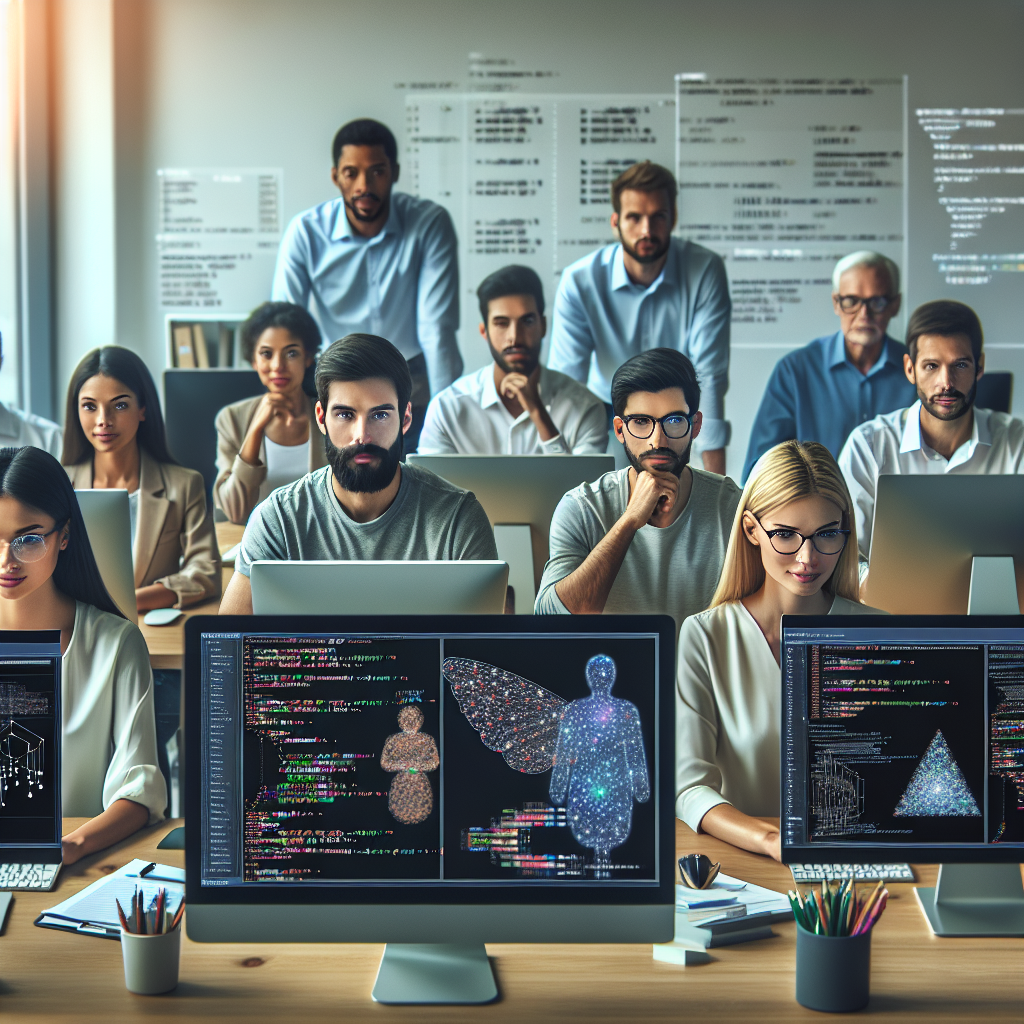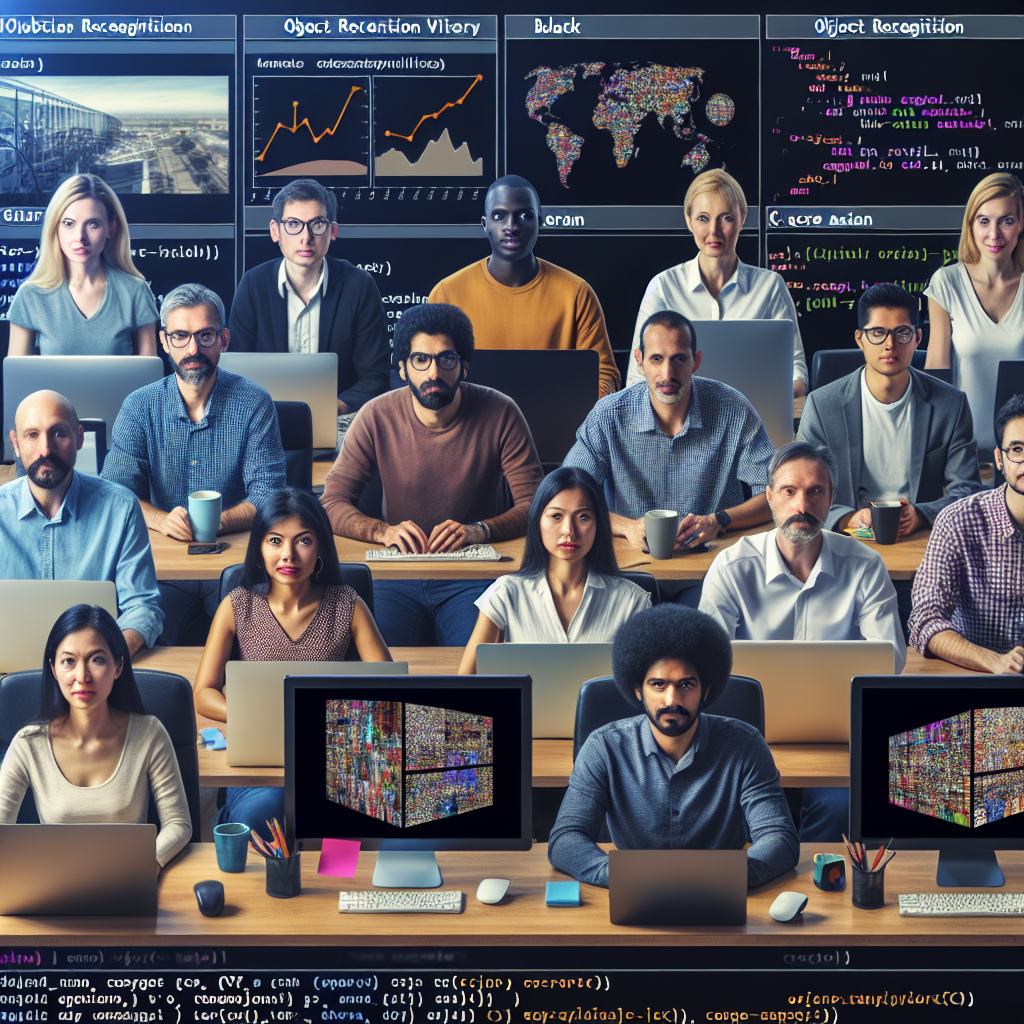Development of IT Projects in Object Recognition and Computer Vision Using OpenCV and dlib

Why Order the Creation of Projects Using OpenCV and dlib for Your Business Success?

Are you ready to take your business to the next level? ⭐ In todays fast-paced world, leveraging technology can make a significant difference. One powerful way to do this is by ordering the creation of projects using OpenCV and dlib. But why specifically these technologies? Lets explore the reasons.
Unleash the Power of Computer Vision
OpenCV and dlib are front-runners in the field of computer vision, allowing businesses like yours to implement innovative solutions. By integrating these technologies, you can optimize processes, enhance security, and improve customer experiences. For instance, imagine a retail store using object recognition to track inventory automatically. Such applications not only save time but also reduce human error, making work more efficient.
Statistics to Ignite Your Interest
- According to a recent study, businesses using computer vision can improve operational efficiency by up to 30%!
- In industries utilizing object recognition like healthcare and retail, companies have reported reducing operational costs by nearly 25% through automation.
Real-Life Scenarios You Can Relate To
Consider a security company that implemented an OpenCV based surveillance system. Traditional systems require constant human oversight, but with dlib and object recognition, they automated monitoring. As a result, they not only saved costs but also significantly enhanced their capacity to detect suspicious activities. This translation into cost savings and security upgrades could resonate with your own business needs!
Client Success Story
Let’s take a closer look at one of our clients, a local grocery store chain. They struggled with stock management, often leading to overstocking or understocking products. After reaching out to us at artivale.com, we developed a custom system using OpenCV for real-time inventory tracking. The new system reduced wastage by 40% and optimized restocking times. The quick turnaround helped them regain losses while enhancing customer satisfaction. This is precisely why you should consider ordering the creation of projects using OpenCV and dlib.
Full Spectrum of Services at Your Fingertips
When you choose artivale.com, you are not just getting a project; you are gaining a partner. With over 20 years of experience and a team of professional specialists, we offer all services in one place — from development to technical support. No need to juggle between multiple service providers! ⭐ You can call us directly at [email protected] or visit artivale.com to sign up for our services.
Why We Stand Out
We understand the nuances and complexities of Development and IT object recognition. Our unique selling point lies in offering comprehensive solutions tailored for your needs. Our personalized approach means that we analyze your business challenges and align our computer vision solutions accordingly. This ensures optimal results and long-term success.
How to Get Started?
It’s simple! Contact us at artivale.com today to discuss your project needs. By ordering the creation of projects using OpenCV and dlib, youre not just investing in technology; youre investing in your business success! ⭐ Our customer relations manager, Alexandra, is waiting to guide you through your options. Don’t miss the opportunity to elevate your business!
| Service | Price (EUR) |
| Brandbook III Development | 1170 |
| Large Corporate Style | 1638 |
| Landing Page Development on a Wordpress Template | 400 |
| Business Card Website Development with Custom Code | 1700 |
| Catalog Website Development on Wordpress | 3640 |
| Online Store Development on a Template | 1500 |
| SEO Promotion - 10 Keywords | 349 |
| Google Adwords - Initial Setup | 200 |
| Email Newsletter - Standard | 359 |
| iOS Mobile Application Development | 7500 |
Frequently Asked Questions
- What is OpenCV? OpenCV is an open-source computer vision library that helps in image processing and analysis.
- How does dlib work? Dlib is a C++ toolkit that enables machine learning algorithms, focusing on running fast and efficiently.
- Can OpenCV and dlib be integrated? Yes, they work exceptionally well together for enhancing image analysis capabilities.
- What industries benefit from these technologies? Industries such as retail, security, healthcare, and automotive heavily utilize computer vision technology.
- How can this technology save costs? Streamlined operations through automation reduce labor costs and improve accuracy, saving money.
- Is training needed to use these technologies? Some knowledge of programming and image processing is beneficial for effective implementation.
- What type of projects can I order? You can order everything from surveillance systems to automated retail inventory solutions.
- How long does it take to complete a project? It generally depends on the projects complexity, but we strive for timely delivery.
- What support do you offer post-development? We provide ongoing technical support and assistance for all developed solutions.
- How can I reach your team? You can contact us via phone or through our website artivale.com.
What You Need to Know About Development and IT Object Recognition in Computer Vision Today

Welcome to the exciting world of computer vision! ⭐ Today, we’re diving deep into the realms of Development and IT object recognition. Its not just a buzzword; its a game-changer for businesses globally. So grab a seat and let’s explore what you need to know to keep your business ahead of the curve!
Understanding the Basics of Computer Vision
At its core, computer vision involves enabling machines to interpret and understand visual information from the world. Imagine teaching a computer to understand images just like we do. From detecting faces in photos to identifying defective products on a production line, the possibilities are immense. By utilizing OpenCV and dlib, you can harness this power for your business.
Key Technologies in Object Recognition
- OpenCV: A versatile library designed for real-time computer vision applications, allowing developers to address numerous problems related to image processing.
- dlib: Known for its robust machine learning capabilities, dlib excels in tasks like object detection and facial recognition.
- Deep Learning: Algorithms powered by neural networks significantly enhance object recognition capabilities, providing high accuracy in identifying complex patterns.
Importance of Object Recognition in Various Industries
The impact of object recognition stretches across multiple sectors, each facing unique challenges:
- Retail: Automated inventory management systems are becoming the norm. Retailers use computer vision to track stock levels, identify theft, and enhance customer engagement through personalized shopping experiences.
- Healthcare: In medical imaging, object recognition aids in diagnosing conditions accurately and swiftly, leading to better patient outcomes. Machines can analyze images from X-rays or MRIs, identifying anomalies that a human eye might miss.
- Automotive: Self-driving cars rely heavily on computer vision for navigation and obstacle detection, ensuring safety on the roads through real-time analysis of surroundings.
Statistics That Matter
Here are some compelling statistics that underline the importance of investing in IT object recognition:
- MarketsandMarkets estimates the computer vision market will reach USD 25.32 billion by 2024, growing at a CAGR of 7.7%.
- Companies utilizing object recognition report an average efficiency improvement of 30% in operations.
Challenges in Development
While the benefits are clear, several challenges come with developing IT object recognition systems:
- Data Quality: The performance of machine learning models heavily depends on the quality and quantity of data. Poor data can lead to inaccurate predictions.
- Maintenance: Continuous updates and improvements are necessary to adapt to changing environments and data variations.
- Integration: Seamless integration with existing systems can pose hurdles, requiring expert knowledge and strategic planning.
Getting Started with Your Object Recognition Project
By now, you may be wondering, “How can I implement this for my business?” Here are a few steps to consider:
- Identify Your Needs: Understand which specific problems you want to solve using object recognition.
- Choose the Right Tools: Familiarize yourself with OpenCV and dlib as well as other technologies that align with your project requirements.
- Seek Expert Help: Collaborating with experienced developers can significantly enhance your chances of project success. At artivale.com, we provide unparalleled IT solutions tailored for your unique challenges.
Why Choose Us?
At artivale.com, we are committed to harnessing the latest advancements in computer vision. Our professional specialists have over 20 years of combined experience, ensuring high-quality outcomes for your projects. Not only do we develop cutting-edge systems, but we also offer complete technical support to guarantee ongoing success. You can reach us at [email protected] or sign up online at artivale.com today!
| Service | Price (EUR) |
| Website Redesign | 1200 |
| Online Store Development | 4500 |
| Email Newsletter - Standard | 359 |
| Android Mobile Application Development | 7500 |
| SMM Promotion - JUNIOR Package | 859 |
| Catalog Website Development on Wordpress | 3640 |
| SEO Promotion - 20 Keywords | 499 |
| Google Adwords - Monthly Support | 50 |
| Brandbook II Development | 684 |
| Label Design Development | 70 |
Frequently Asked Questions
- What is object recognition? Object recognition is the process of identifying and labeling objects in an image or video frame.
- How does computer vision differ from traditional imaging? Computer vision goes beyond capturing images; it interprets and understands them, enabling automated decision-making.
- Can I use existing equipment for these projects? Yes, many projects can be implemented using existing hardware, though specialized tools may enhance performance.
- What are the common applications of computer vision? Applications range from face recognition, autonomous vehicles, quality inspection, and retail analytics.
- How secure are these technologies? Modern solutions include robust security measures such as encryption and compliance with industry standards.
- Do I need coding skills to implement these solutions? While basic knowledge helps, collaborating with specialists at artivale.com can simplify the process.
- What is the average cost of these projects? Costs can vary widely based on complexity and requirements; please consult our pricing table for estimates.
- Are there any ongoing maintenance needs? Yes, regular updates and maintenance are essential to adapt to changing data and optimal performance.
- How long does it take to develop these systems? Development time can range from weeks to months depending on project complexity and scale.
- Can these systems integrate with my current operations? Yes, our experts can help ensure smooth integration with your existing IT infrastructure.
Common Myths About OpenCV: Debunking Misconceptions in Computer Vision Projects

In the realm of computer vision, OpenCV has emerged as a leading framework, yet it is shadowed by various misconceptions that can deter businesses from fully harnessing its potential. ⭐️♂️ Today, let’s clear the air and debunk common myths surrounding OpenCV and its role in Development and IT object recognition.
Myth #1: OpenCV is Only for Academic Use
Many believe that OpenCV is only suitable for academic research and experimentation. This is far from the truth! While it’s true that OpenCV is an excellent tool for academic projects, it is extensively used in the industry as well. From autonomous vehicles to retail analytics, many companies rely on OpenCV for practical, real-world applications. A prime example is Uber, which uses this technology for various aspects of its transportation services.
Myth #2: You Need Extensive Coding Skills
Another common misconception is that you need to be a coding wizard to use OpenCV. ⭐ This myth can be discouraging for beginners interested in object recognition. While a basic understanding of programming can certainly help, there are plenty of resources, tutorials, and community support available to get you started. Additionally, our team at artivale.com can assist with your project, allowing you to focus on your business goals rather than getting bogged down in technical details.
Myth #3: OpenCV is Outdated
Some folks believe that OpenCV is an outdated framework. On the contrary, OpenCV is constantly evolving! With rigorous updates and a vibrant community, it regularly integrates the latest advancements in computer vision. In fact, the recent versions focus on improving performance and complementing modern hardware, making it more relevant than ever. By choosing OpenCV, you’re investing in a cutting-edge solution for your business.
Myth #4: Object Recognition is 100% Accurate
A widespread illusion is that object recognition systems, including those built with OpenCV, are infallible. While they have made incredible strides in accuracy, they aren’t perfect. Environmental factors, image quality, and training data quality can all affect the performance of such systems. However, with adequate training and constant improvements, you can achieve remarkable results that significantly enhance business operations.
Myth #5: OpenCV is Only for Image Processing
Many assume OpenCV is limited to image processing, but its capabilities extend far beyond that. It can handle video analysis, real-time processing, facial recognition, and motion tracking, making it a comprehensive solution for myriad projects. Whether you’re creating a surveillance system or enhancing user interactions through augmented reality, OpenCV is versatile enough to meet various needs.
Why Misconceptions Matter
Understanding these myths is crucial for successful project implementation. Not addressing misconceptions can lead to missed opportunities and hesitation in adopting technology that could greatly benefit your operations. With over 20 years of experience, the team at artivale.com ensures that you not only benefit from the right technologies but also understand their true potential. Our experts are here to guide you through correct usage for optimal results!
Real-World Applications: Breaking the Myths
Consider a local security company that integrated OpenCV for facial recognition. Initially wary due to myths, they proceeded cautiously. After overcoming their hesitation, they discovered that not only was OpenCV easy to implement with their existing systems, but it significantly improved their security protocols! The results? A reduction in security breaches and increased client satisfaction.
Get Started with Confidence!
If these myths have held you back, now’s your chance to step forward with confidence! Choosing to partner with professionals can eliminate uncertainties in your project development. At artivale.com, we offer tailored support for all your Development and IT object recognition needs, helping you leverage OpenCV for your business success. Don’t hesitate to reach out — you can contact us at [email protected] or visit our website artivale.com today!
Frequently Asked Questions
- What is OpenCV mainly used for? OpenCV is primarily used for computer vision tasks like object detection, face recognition, and video analysis.
- Do I need special hardware to use OpenCV? Generally, no! OpenCV can run on a variety of hardware, including standard PCs, making it accessible for many users.
- How often is OpenCV updated? OpenCV is regularly updated with new features, optimizations, and patches based on user feedback and technological advancements.
- Can OpenCV be used in mobile applications? Yes, OpenCV can be integrated into mobile apps for Android and iOS to enhance functionality.
- Are there alternatives to OpenCV? Yes, there are several libraries like TensorFlow and Matplotlib, but OpenCV remains one of the most comprehensive solutions.
- Is it difficult to learn OpenCV? The learning curve can vary, but with plenty of online resources and community support, many find it quite manageable.
- How does OpenCV compare to other computer vision tools? OpenCV is open-source, highly efficient, and has a large community, making it favorable compared to some proprietary tools.
- Can OpenCV handle video input? Absolutely! OpenCV is equipped to process video streams in real-time, enabling advanced applications.
- What programming languages does OpenCV support? OpenCV primarily supports C++, Python, and Java, making it versatile for developers.
- What kind of projects can I implement with OpenCV? You can implement a wide range of projects, from real-time facial recognition to object tracking in security systems.
Submit your details in the form and our team will personally get in touch with you within the next business day to discuss your needs
